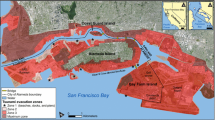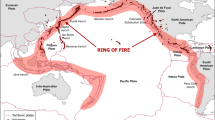Abstract
A major tsunamigenic earthquake is expected in the near future along the coast of West Sumatra Province of Indonesia. In the city of Padang, the arrival time of the tsunami is expected to be ~30 min. Currently, there are approximately 400,000 people in the city living within the potential inundation zone. This study aimed to complement the existing research in appraising possible risk reduction interventions, specifically looking at enabling the timely evacuation of the area. This research, developed in consultation with national and local authorities, emergency planners and NGOs, analysed interventions for tsunami risk reduction in Padang through the development of a pedestrian and vehicular evacuation model and the appraisal of possible solutions to enhance the evacuation rates. Some of the conclusions from this research can be applied to other areas in Southeast Asia where the traffic patterns are similar to those in Padang and where the distance to safety is greater than 4–5 km. For the case of Padang, the results show that pedestrian evacuation is strongly preferable to vehicular evacuation due to the limited road capacity and the high population density. In the present situation, however, 70–80 % of the population in Padang could not evacuate within 30 min, even by foot. Common interventions such as widening roads and building bridges prove to be relatively ineffective in this case due to the large distance that has to be covered in a short time. These interventions would only have a decisive impact if a longer evacuation time was available (more than 60 min). In the case of Padang, the evacuation rate in the first 30 min is strongly dependent on the presence/absence of evacuation shelters, whose effectiveness is limited by the capacity of the structures. Building a few high-capacity and high-resilience structures such as evacuation hills is a more effective and robust evacuation strategy than constructing many small high-raised buildings. Even with evacuation structures, wider roads and bridges, about 20 % of the population would still be unable to reach safety by the time the tsunami arrives. This means about 70,000 people of Padang’s current population, which is rapidly increasing. The building of evacuation shelters may be a viable option for saving lives in the short term, but it is not a sustainable option in the medium to long term. It is therefore also necessary to set up and enforce regulations for land use planning that take into account the tsunami risk and prevent further urban development for the areas that may be affected by a tsunami.












Similar content being viewed by others
References
Alarcon J, Mulyani R, Whittle, Siau JD (2009) The Padang, Sumatra, Indonesia Earthquake of 30 September 2009. In: Wilkinson S (ed) field report from the Earthquake Engineering Field Investigation Team (EEFIT), London
Andriani DC (2012) Gempa Susulan Memaksa Warga Padang Mengungsi. Available from: http://www.zamrudtv.com/sumbar-4510-gempa-susulan-memaksa-warga-padang-mengungsi.html. Accessed 17 April 2012
Asian Development Bank (2010) Key Indicators for Asia and the Pacific 2010. Mandaluyong City, Philippines
Avouac JP, Konca AO et al (2008) Partial rupture of a locked patch of the Sumatra megathrust during the 2007 earthquake sequence. Nature 456(7222):631–635
Bappenas and BNPB (2010) National Action Plan for Disaster Risk Reduction (NAP-DRR) 2010-2012. Available at www.bnpb.go.id/website/file/pubnew/99.pdf
Borrero JC, Sieh K, Chlieh M, Synolakis CE (2006) Tsunami inundation modeling for western Sumatra. Proc Natl Acad Sci USA 103(52):19673–19677
BPS Kota Padang (2005) Kecamatan dalam angka—subdistricts in numbers. Statistical bureau (BPS) Kota Padang, Padang
BPS Kota Padang (2010) National Statistics Kota Padang
Brooks O (2010) Tsunami alert, beating Asia’s next big one. Nanyang Technological University, Singapore
Cedillos V (2011) Report on crucial need for Tsunami evacuation solutions for Padang. GeoHazards International Report, West Sumatra
Chandra S, Kumar U (2003) Effect of lane width on capacity under mixed traffic conditions in India. J Transp Eng 129(2):155–160
Departemen Pekerjaan Umum (1997) Manual Kapasitas Jalan Indonesia (Indonesian Highway Capacity Manual) Direktorat Jenderal Bina Marga, Indonesia
Di Mauro M, Lees M, Megawati K, Huang Z (2013) Pedestrian-vehicles interaction during evacuation: agent-based hybrid evacuation modelling of Southeast Asian cities. Pedestrian and Evacuation Dynamics 2012
Drabek TE (1986) Human system responses to disaster: an inventory of sociological findings. Springer, New York
EERI (2011) The March 11, 2011, Great East Japan (Tohoku) Earthquake and Tsunami: societal dimensions, EERI special earthquake report. Available at eqs.eeri.org. Accessed 6 August 2012
FEMA (2008) Guidelines for design of structures for vertical evacuation from Tsunamis, Federal Emergency Management Agency report P646
Gayer G, Leschka S, Nohren I, Larsen O, Gunther H (2010) Tsunami inundation modelling based on detailed roughness maps of densely populated areas. Nat Hazards Earth Syst Sci 10(8):1679–1687
GITEWS (2010) Tsunami Evacuation Map Padang. Available at http://www.gitews.org/tsunami-kit/en/id_tsunami_evacuation_map_padang.html. Accessed 6 August 2012
Gordon RL (1969) Technique for control of traffic at critical intersections. Transp Sci 3(4):279–288
Helbing D, Treiber M (1999) Numerical simulation of macroscopic traffic equations. Comput Sci Eng 1(5):89–99
Hoang TL, Miska M et al (2010) Simulating motorbike dominated Traffic. 12th World Conference on Transport Research. Lisbon, Portugal
Hoogendoorn SP, Daamen W (2005) Pedestrian behavior at bottlenecks. Transp Sci 39(2):147–159
Hoppe M, Mahadiko HS (2010) 30 minutes in Padang—lessons for tsunami early warning and preparedness from the earthquake on 30 September 2009. GTZ-GITEWS project publication
Imamura F, Muhari A et al (2012) Tsunami disaster mitigation by integrating comprehensive countermeasures in Padang city, Indonesia. J Disaster Res 7(1):48–64
Kerner BS (2009) Introduction to modern traffic flow theory and control. Springer, Berlin
Korhonen T, Hostikka S, Heliovaara S, Ehtamo H (2010) FDS+Evac: an agent based fire evacuation model. Pedestr Evacuation Dyn 2008:109–120
Kretz T, Grunebohm A et al (2008) Upstairs walking speed distributions on a long stairway. Saf Sci 46:72–78
Lammel G, Grether D et al (2010) The representation and implementation of time-dependent inundation in large-scale microscopic evacuation simulations. Transp Res Part C Emerg Technol 18(1):84–98
Latané B, Williams K, Harkins S (1979) Many hands make light the work: the causes and consequences of social loafing. J Pers Soc Psychol 37(6):822–832
Lee DC (2006) Proof of a modified Dijkstra’s algorithm for computing shortest bundle delay in networks with deterministically time-varying links. IEEE Commun Lett 10(10):734–736
Luke S, Cioffi-Revilla C, Panait L, Sullivan K, Balan G (2005) MASON: a multi-agent simulation environment. Simul Trans Soc Model Simul Int 82(7): 517–527
MapAction (2009) Indonesia: Sumatra earthquake affected area, population density in 2003, Available at http://ochaonline.un.org/OchaLinkClick.aspx?link=ocha&docId=1132551. Accessed 6 August 2012
McCloskey J, Antonioli A, Piatanesi A, Sieh K, Steacy S et al (2008) Tsunami threat in the Indian Ocean from a future megathrust earthquake west of Sumatra. Earth Planet Sci Lett 265(1–2):61–81
Mileti DS, Sorensen JH (1990) Communication of emergency public warnings: a social science perspective and state-of-the-art assessment. Oak Ridge National Laboratory for the Federal Emergency Management Agency, Oak Ridge Tennassee
Muhari A, Imamura F et al (2010) Tsunami mitigation efforts with pTA in West Sumatra province, Indonesia. J Earthq Tsunami 4(4):341–368
Muhari A, Imamura F, Koshimura S (2012) Tsunami-deck: an introduction concept for a new type of vertical tsunami evacuation shelter. Proceedings of the 59th Conference on Coastal Engineering, 2012 (available at http://jglobal.jst.go.jp/public/20090422/201202246025296440#jgid201202246025296440)
Natawidjaja DH, Sieh K et al (2006) Source parameters of the great Sumatran megathrust earthquakes of 1797 and 1833 inferred from coral microatolls. J Geophys Res 111(B06403):1–37
Parker DJ, Priest SJ, Tapsell SM (2009) Understanding and enhancing the public’s behavioural response to flood warning information. Meteorol Appl 16:103–114
Post J, Wegscheider S et al (2009) Assessment of human immediate response capability related to tsunami threats in Indonesia at a sub-national scale. Nat Hazards Earth Syst Sci 9(4):1075–1086
Sharma U, Patwardhan A, Parthasarathy D (2009) Assessing adaptive capacity to tropical cyclones in the East coast of India: a pilot study of public response to cyclone warning information. Climatic Change 94:189–209
Sieh K et al (2008) Earthquake Supercycles Inferred from sea-level changes recorded in the corals of West Sumatra. Science 322(5908):1674–1678
Taubenbock H, Goseberg N et al (2009) “Last-Mile” preparation for a potential disaster—interdisciplinary approach towards tsunami early warning and an evacuation information system for the coastal city of Padang, Indonesia. Nat Hazards Earth Syst Sci 9(4):1509–1528
The Eclipse Foundation (2012) The eclipse foundation open source website, www.eclipse.org
Trajfel H (1978) Social characterisation, social identity and social comparison. In Tajfel H (ed) Differentiations between social groups, Academic Press: New York pp 61–76
Turner RH (1964) Collective behaviour. In: Faris REL (ed) Handbook of modern sociology. Rand-McNally, Chicago, pp 382–425
USGS (2010) The Padang, Indonesia Earthquake of 2009 http://gallery.usgs.gov/videos/283
USGS (2012) M8.6 and M8.2 Northern Sumatra, Indonesia earthquakes of 11 April 2012, available at http://earthquake.usgs.gov/earthquakes/eqarchives/poster/2012/20120411.php. Accessed 6 August 2012
Weidman U (1993) Transporttechnik der Fussganger., in Schriftenreihe des IVT, ETH: Zurich
World Health Organisation (2007) Earth Quake in Padang, West Sumatra Province, Indonesia, Emergency Situation Report 1, 6 March 2007. Available at www.who.int/hac/crises/idn/sitreps/en/index.html. Accessed 6 August 2012
World Health Organisation (2009) Earthquake in Padang, West Sumatra Province, Republic of Indonesia, Emergency Situation Report (ESR-16), 3 November 2009. Available at www.who.int/hac/crises/idn/sitreps/en/index.html. Accessed 6 August 2012.
Acknowledgments
The authors would like to acknowledge and thank the consultees that participated in this study, specifically Badan Nasional Penanggulanggan Bencana, Badan Penanggulangan Bencana Daerah, Kogami, the Australia–Indonesia Facility for Disaster Reduction and Mercy Corps. We would also like to thank Dr Li Lin Lin, Dr Meya Yanger Walling, Nicole Shufelt, MSc and Dr Annie Winson (Earth Observatory of Singapore, Nanyang Technological University) for providing their valuable comments on the research work and the paper.
Author information
Authors and Affiliations
Corresponding author
Rights and permissions
About this article
Cite this article
Di Mauro, M., Megawati, K., Cedillos, V. et al. Tsunami risk reduction for densely populated Southeast Asian cities: analysis of vehicular and pedestrian evacuation for the city of Padang, Indonesia, and assessment of interventions. Nat Hazards 68, 373–404 (2013). https://doi.org/10.1007/s11069-013-0632-z
Received:
Accepted:
Published:
Issue Date:
DOI: https://doi.org/10.1007/s11069-013-0632-z




